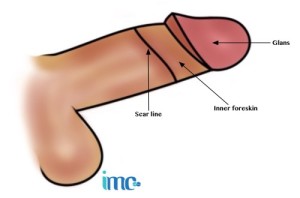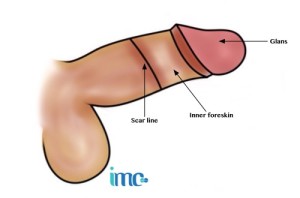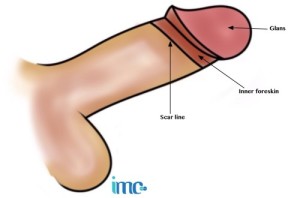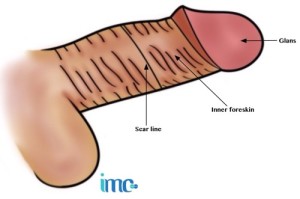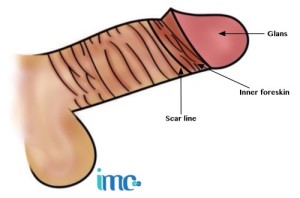We are pleased to announce we have won the WhatClinic Patient Service Award. We would like to thank all the families that have trusted us with your health and we strive to continue to provide an excellent service to all.
Coronavirus Update for Circumcision Bookings
Due to the unfolding situation with Coronavirus (COVID-19), we’re very sad to have to let you know we’ll be temporarily closing our clinic from the 29th March 2020.
We know the coming days and weeks will be filled with uncertainty and we want to help support families who have had procedure with us as best we can. We are still available to support patients on our usual emergency telephone numbers.
When the time is right, we look forward to welcoming you back to our clinic. We recommend filling out our reservation form so that we can contact you as soon as we re-open.
Please help your community through this time by avoiding all non-essential travel and social contact.
Plastibell Circumcision
The key feature of the Plastibell method is the use of the “bell”. This method causes the foreskin foreskin to fall off naturally by blocking blood supply, in a similar fashion to how an umbilical cord falls off. This contrasts with surgical methods where a cut is made to remove the foreskin – this will involve bleeding and require suturing to close the wound. Minimal bleeding and the lack of sutures are some of the key benefits with this device.
The procedure starts by ensuring adequate pain control. Many forms of pain relief exist including local anaesthetic injections, and topical local anaesthetics such as creams and sprays. The ideal regimen for a pain-free circumcision is a topical application plus an injection given by experienced hands. The local anaesthetics obtains a high level of pain control however other forms of sensation are still intact so the procedure may remain uncomfortable for the child. How these sensations are interpreted is variable, and depends on the child’s level of anxiety and calmness. That’s why we use also use multimedia devices to engage the child. encourage parents of slightly older children to be calm and recommend parents read of our advice about psychologically preparing a child for circumcision.
After the anaesthetic, an antiseptic is applied and the area is gently cleaned with swabs. A small incision is made from the tip of the foreskin down towards the middle of the penile shaft to allow for the bell to be inserted:

The bell is placed around the glans (head of the penis):
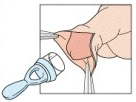
The foreskin is pulled over the device. A suture (surgical string) is tied tightly around the ring from the outside of the foreskin. This string blocks blood flow to the foreskin. Excess foreskin, that is now without blood supply and therefore at low risk of bleeding, is now surgically removed for a more hygienic healing process.

Depending on the level of pain at this point, a judgement is made as to whether more anaesthetic may be useful. The IMC never charges an extra fee for additional anaesthetic post-operatively as our goal is to provide a pain-free, or as close as is possible to get to a pain-free, circumcision procedure.
During the healing and recovery process, the area might be sore and sensitive so it is important to use the oral analgesic and ointment we give and ensure prompt nappy changes. After-care information to achieve a comfortable and healthy recovery will be provided in printed form on the day of the procedure. As the blood flow is now restricted to the foreskin, it will fall off naturally along with the bell around a week later or a bit longer for older children. By the time the ring falls off, the healing process would be complete. The result will be a neat cut due to the perfectly circular line formed by the string.
ShangRing Circumcision
Advances in circumcision surgery have stagnated in recent decades. Ten years ago however, a landmark medical publication showed that circumcision strongly reduced the risk of HIV transmission in male participants of a clinical study, generating renewed interest in circumcision by the World Health Organisation and health officials worldwide. Realising that circumcision may help contain the HIV/AIDS epidemic in high-prevalence areas such as in Africa, researchers sought to find newer ways to perform circumcision that are more convenient for men and that are more likely to achieve high uptake. The Bill and Melinda Gates Foundation funded research to create the Shang Ring, a new circumcision device that fits this purpose.

The main benefits of the Shang Ring are:
- reduced pain
- minimal bleeding
- requires no stitching
- requires no bandages
- showering as normal during recovery
- minimal time off work needed
- no stitching marks
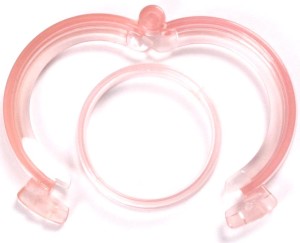
During the early stages of development, Dr. Said Bakir was invited to be an expert observer of the Shang Ring procedure. Today, years later, the Shang Ring has proved to be a very effective method of circumcision in high-prevalence areas. The IMC Circumcision Clinic London is the only private circumcision centre in the region to offer Shang Ring circumcision. Tens of thousands of men worldwide and hundreds at our own clinic report that they are very satisfied with the results that this device achieves.

Dr. Bakir with the inventor of ShangRing
[youtube http://www.youtube.com/watch?v=_ovf8GYfNbw&theme=light]
Read more about our adult circumcision services.
Types of Circumcision Procedures
The IMC is able to offer many methods of circumcision. The Plastibell method is recommended for babies, infants and young boys while surgical methods and the ShangRing™ are more suited to adult men. The method we use depends on the age and size of the glans and your preference. We can often offer more than one method to you – this can be discussed during the consultation. Click to read more about these methods:
NHS Circumcision
The National Health Service (NHS) took the decision not to offer circumcision for religious, cultural, social or personal reasons – also known as non-therapeutic – in 1949, very soon after its inception. This is because circumcision is not a medical necessity. Their decision led to a decline in the number of individuals undergoing circumcision in the United Kingdom.
A number of NHS hospitals did re-start offering offer a free circumcision service locally to parents, especially during the 1980s, however this is this is now rare or non-existent.
The situation may be changing in light of recent data showing that the impact of circumcision on HIV prevention is greater than what was previously thought. For this reason, the United States Public Health Department (the CDC) have recently change their stance on circumcision and state that the the benefits now outweigh the risks and recommend circumcision. In the last decade, many organisations fighting HIV, such as the Bill and Melinda Gates Foundation, have launched circumcision promotion campaigns in Africa to prevent HIV.
Non-therapeutic circumcision on the NHS
Circumcision is common among certain religious groups (such as Muslims and Jews) and cultural backgrounds. The NHS generally funds circumcision for specific medical reasons therefore most non-therapeutic circumcisions must be funded privately. Individual Clinical Commissioning Groups (CCG) (who locally decide how to spend NHS money) may choose to fund non-therapeutic circumcision for their local populations. We try keep an up to date list of CCGs and NHS providers that offer circumcision services:
- Tower Hamlets CCG: until recently, GPs in Tower Hamlets were able to refer to a CCG-run circumcision service however this was not a free service. The service ended in early 2016 and patients are now adviced to seek a private provider
- Sheffield Hospital: After ceasing free non-therapeutic circumcision in 2013, Sheffield Hospital now offer a paid service for children aged six months and above for £850
- All other NHS trusts have stopped offering free circumcision
Patients may be considered on an individual basis where their GP or consultant believes there is an exceptional circumstance that warrants deviation from the normal rules. Individual cases are considered by a treatment panel at the CCG. You can find out about ‘Individual Funding Requests’ by visiting your local CCG website (use the CCG finder tool on the NHS website) or speaking to your GP.
Therapeutic circumcision on the NHS
The NHS provides circumcision free of charge when a urologist decides there is a medical reason for the procedure. The most common reasons are:
- Phimosis
- Paraphimosis
- Recurrent balanitis
- Balanitis xerotica obliterans
To get this type of circumcision on the NHS, see your GP who will make a referral to a local hospital urology service. There is usually a delay to see the urologist for non-urgent referrals. The urologist will then examine you or your child to decide whether an alternative treatment might be useful. If circumcision is offered, a circumcision appointment in theatre will be booked. There is usually another delay with this as it’s unlikely to be considered urgent.
Waiting list times for NHS circumcision can vary from between 8 weekss to 32 weeks, varying greatly between different areas of the United Kingdom and the severity of the condition, however even minor to moderate pain is not usually considered an urgent situation. Situations where an operation can be arranged quickly include:
- Where there is a suspicion of cancer where a 2-week wait referral may be arranged by your GP. The urologist may examine you and decide to operate as soon as possible.
- Paraphimosis can be a medical emergency and an emergency circumcision may be performed. Paraphimosis is when the foreskin is retracted and cannot be replaced. This results in swelling and colour change of the tip, pain in the penis and may also result in the inability to pass urine. This condition requires immediate attention.
Health Insurance
In the UK, health insurance only covers therapeutic (medical) circumcision. If you have health insurance, your GP will still need to make a referral and then an appointment can be made through your insurance provider. The operation can usually occur much sooner through this route than through the NHS.
Private circumcision clinics such as the IMC
Individuals looking for a private circumcision service for themselves or their son should choose a doctor-led circumcision clinic or a hospital. Ask the doctor who is operating about the level of experience he or she has. Some patients choose to fund their own therapeutic circumcision despite this being available on the NHS. If you choose a private clinic, the main disadvantage is cost. The main advantages are:
- individual choice whether you would like to undergo circumcision, no GP referral required
- no long waiting lists
- avoidance of hospital-acquired infections such as MRSA
- no hospital admission required
- usually, a method of circumcision is used that requires only local anaesthetic
- more flexibility to choose the doctor
- less embarrassment within a private environment the clinic can provide
- no need to attend hospital in the early morning and wait your turn on the theatre list
Circumcision Infection: Recognition and Treatment
Using correct technique, circumcision has a low complication rate. An infected circumcision is an uncommon complication and is often minor. When infections occur after surgery, they are usually due to the disruption of the skin that acts as a barrier against infection. However clearly not all disruptions to the skin result in infections: we do not expect a child’s knee to become infected every time they trip and fall onto it. Similarly, as circumcision is a relatively minor surgical procedure, the chance of an infection developing is low when conducted under sterile conditions. For circumcision, there is no need for prophylactic (preventative) antibiotics.
While infection is a possible complication of circumcision in the short-term, circumcision actually reduces the risk of urinary tract infections, balanitis, HIV and many other infections of the urinary system in the long-term.
The information on this page is provided as a guide only. This information does not replace the advice of a doctor. If you have any concerns about your or your child’s health, you should contact the doctor that performed the circumcision, your GP or an appropriate medical professional. If you are one of our patients, you will know that you can contact us at any time when you are concerned.
How to recognise an infection after circumcision
The following may occur during healing and are not signs of an infected circumcision:
- a small amount of blood droplets seen on the nappy or underwear in the first days after circumcision
- yellowish scabs forming on the glans (head of the penis) where adhesions were removed or around the cut edge
- bruising near the base of the shaft of the penis if local anaesthetic injections were used during the procedure
- a small amount of clear discharge around the wound site which is a normal sign of dying skin seen in the Plastibell technique. The discharge is sometimes foul-smelling however when this happens, it is often difficult for parents to decide if there is an infection or not. Therefore seeking advice is a good idea.
- pain in the first few days after circumcision and for children, around the time the Plastibell ring is close to falling off. Painkillers are advised during these times. If there are delays in the ring falling off, contact us as we can offer advice or bring the child in to accelerate removal.
These however, may be signs of an infection and medical advice should be sought as soon as possible:
- discharge that includes pus (cloudy, yellowish/white, foul-smelling fluid)
- hot skin and/or spreading redness around the wound site
- fever
Other than infection, these are also signs for which medical advice should be sought
- bleeding that does not stop within a few minutes, or a spot of blood in the diaper larger than a pound coin
- excessive pain
- a large amount of swelling
- discolouration of the penis (could be signs of insufficient blood flow or infection)
- not making urine
- child unable to be comforted
- drowsy child
What to do if you are concerned
Contact the team that performed the circumcision in the first instance. If you are our patient, you can contact us on the emergency number we provided during your appointment at any time. The alternative avenues for medical care are your GP, NHS Direct by calling 111 (who can arrange an appointment with an out-of-hours doctor) or in an emergency, you should call 999 or attend your local emergency department. For most situations, calling your own team that performed the circumcision first is advisable as they will be most familiar about what is normal during the healing process.
How to treat infection
An infection should be assessed by an experienced professional. If an infection is suspected, the usual treatment is antibiotics after other causes of the symptoms are excluded. The most common antibiotic for mild infections is flucloxacillin which has penicillin (never use medication that has been prescribed for someone else). The signs of the infection should start to settle within 3-5 days. A generally unwell adult or child with a skin infection may need to be admitted to hospital and have stronger antibiotics and closer monitoring however this is rare – in over 20 years, none of our doctor’s patients have ever needed this.
Read more at Patient.info
Circumcision Styles
This page illustrates some of the different styles of circumcision. Most men do not offer a preference for a particular style. But with many circumcision methods, there is a degree of flexibility in the amount and location of the foreskin that is removed. These are the two most important aspects determining the final circumcision style. Patients who are interested in a particular style can discuss this with the doctor during a consultation.
Tightness (tight or loose): The amount of foreskin removed determines how tight the remaining skin covering the shaft is destined to be. Removing less foreskin results in a “loose circumcision”; removing more results in a “tight circumcision”. Tight circumcisions should nevertheless be comfortable due to the skin’s elastic potential.
Position (high or low): During the circumcision, a portion of foreskin is removed. The remaining skin of the shaft and the remaining foreskin are then brought close together to heal and fuse. The point of fusion becomes the permanent scar line. A “high circumcision” involves removing more of the shaft’s skin resulting in a scar line closer to the middle of the penile shaft. A “low circumcision” involves removing less of the shaft’s skin and more of the foreskin resulting in a scar line closer to the tip of the penis.
The length of the penile shaft also plays a role in the perceived tightness of circumcision. With a longer shaft, a tight circumcision results in higher manoeuvrability than a shorter shaft, as the extra skin gives more room to stretch and the impression of a looser circumcision. By contrast, some men perceive that a tight or normal circumcision is tighter than it actually is when there is less shaft skin available. In any case, these issues are not usually a significant bother to circumcised men.
Normal Circumcision Style
This circumcision style is most commonly performed. It results in a mildly tight circumcision and a common scar line location.
High and Tight Circumcision
This style results in increased tightness of the skin during an erection, however not tight enough to cause discomfort.
Low and Tight Circumcision
The scar line is much closer to the glans resulting in less of the original foreskin remaining.
High and Loose Circumcision
The glans can still be exposed with less foreskin removal, with the resulting shaft having looser shaft skin.
Low and Loose Circumcision
Similar to the style above, but with the scar line closer to the glans.
What else affects the outcome?
The quality of the scar line depends on a number of factors. Firstly, being circumcised in infancy or childhood tends to improve the scar line. Secondly, the type of procedure and the skill and experience of the person performing the circumcision can determine what the resulting scar line looks like. By using devices like the Plastibell for infants and children or the ShangRing for adults, the line is more likely to be perfectly circular and less reliant on skill.
 For more information on styles and circumcision in general, you can visit Circlist.
For more information on styles and circumcision in general, you can visit Circlist.
Any reproduction of these images without explicit permission is okay as long as you credit us (via a normal web link) as the source of it. Also see our old image of circumcision styles.
A wonderful start to 2015 – the WhatClinic award
The IMC Circumcision Clinic London has been awarded the WhatClinic Excellent Customer Service award. This prize is awarded to clinics that demonstrate exceptionally good response rates and quality to customer enquiries by our friendly team. We are incredibly proud of our supporting staff, including Pam who handles the majority of calls and the care after circumcision and Zainab and Karrar who welcome and support everyone who comes through our doors. Well done!
Welcome to the IMC Circumcision London blog!
We warmly welcome you to our shiny new IMC Circumcision London blog. We will use it to share updates about our clinic, useful information about circumcision and circumcision news that our visitors may find useful.
We hope to see you regularly!

